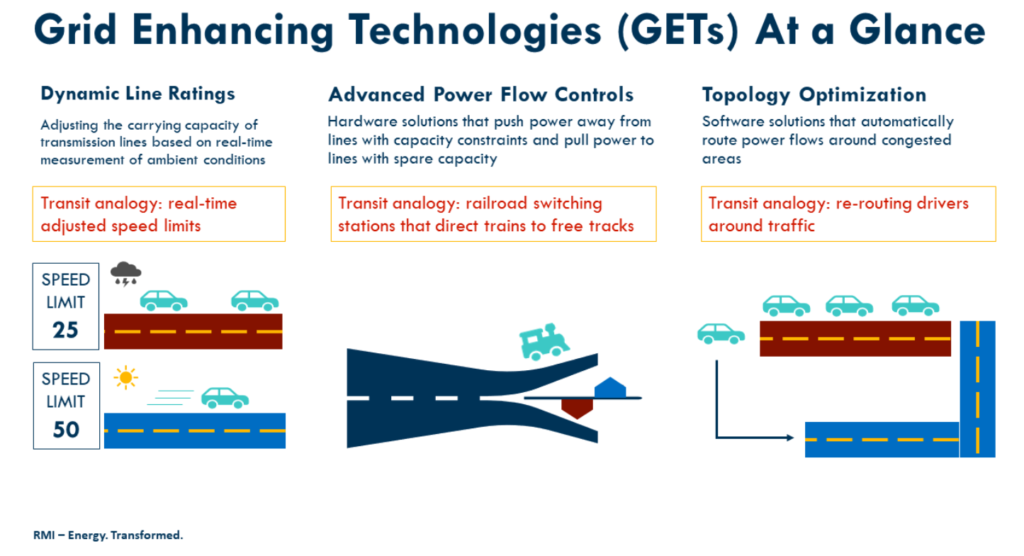
Our electric grid is laboring to keep up with increased demand for electricity as we transition to renewable energy from fossil fuels. Grid congestion, which costs billions of dollars in extra electricity, can result in squandering wind or solar power. US consumers pay over $6B in transmission congestion costs every year, as hundreds of gigawatts (GW) of renewable energy are waiting to connect to the grid but remain stalled in interconnection queues.
But there is excess capacity on today’s wires that could be leveraged to solve these problems. Even without replacing infrastructure, our transmission systems are capable of much more. And that’s where grid-enhancing technologies (GETs) come in. GETs make it possible to increase the amount of power running through existing electricity circuits.
GETs are hardware, software, or a combination of both, that increase the efficiency, capacity, reliability and safety of existing power lines dynamically, faster and at lower cost than building out new grid infrastructure.
How do they work?
Dynamic Line Ratings:
When electrical wires are installed, they’ve been assigned static thermal ratings (indicators of how much heat they can handle). Carrying electricity generates heat in the wires, which causes them to get soft, which can lead to sagging or other issues. Traditionally, static thermal ratings assume hot, sunny, still conditions for calculating the heat capacity of the line; but Dynamic Line Ratings measure the true conditions while the lines are in use to calculate the safe capacity of the lines. On cold or windy days, power lines can often deliver 50% or more energy than their static thermal ratings would indicate.
Advanced Power Flow Control:
Electricity flows along the path of least resistance through the grid network as power is loaded and unloaded at substations. Generation and demand create a push and pull effect. Advanced Power Flow Control devices can automatically or manually adjust the impedance, or total resistance, of a power pathway.
Topology Optimization:
Topology Optimization software evaluates the best use of the network and determines how to re-route power by combining data on generation, demand and the status of grid infrastructure. In a simple case, turning off one power line redistributes power more evenly over the other lines. Topology Optimization software determines optimal topologies and implements the solutions with existing hardware.
Advanced Conductors:
Advanced Conductors use composite and/ or carbon cores, which better manage thermal sag at high temperatures than the traditional Aluminum Conductor Steel Reinforced (ACSR) or Aluminum Conductor Steel Supported (ACSS). Advanced Conductors can operate at higher temperatures for an extended period of time, which allows for up to double the power density on paths using existing structures, which can be critical for supplying additional capacity during system emergencies.

Meanwhile, in Massachusetts:
A panel of clean energy and grid experts submitted a report to the Massachusetts legislature in December 2023 with recommendations on expanding transmission capacity to support the clean energy transition using Grid Enhancing Technologies. The report specifically calls for utilities to invest in optimization and grid enhancement before turning to traditional methods of expansion. This will unlock more capacity for renewables, faster.
To support the effort to implement GETs, the chairs of the Joint Committee on Telecommunications, Utilities and Energy (TUE), Senator Mike Barrett and Representative Jeffrey Roy, introduced An Act Advancing Grid Enhancement Technology (H.4222 and S.2531) to “maximize the capacity, reliability, and efficiency of the state’s transmission system by expanding the scope of applicable strategies, technologies, and deployment options used by distribution companies and the independent system operator of New England.”
GETs create jobs, improve infrastructure and save money. FERC (the Federal Energy Regulatory Commission) issued Order 2023 in July of 2023, which requires transmission operators to consider advanced technologies for new interconnections. But utilities get little or no monetary return from adopting relatively inexpensive approaches, such as energy efficiency measures or GETs, or from funding research and development.
However, regulators at the state level are coming around. It’s going to be critical to “squeeze every drop out of the existing system” to meet the growing need for electricity, said Dan Scripps, chair of the Michigan Public Service Commission “GETs can help us do that—to maximize the value from the infrastructure we have today.”
References:
- Proceedings of the National Academy of Sciences: “Grid-enhancing technologies” can squeeze a lot more power from the existing electric grid
- US Department of Energy: Grid-Enhancing Technologies: A Case Study on Ratepayer Impact
- Watt Coalition: Clean Energy, Grid Experts Recommend GETs as a Priority for Massachusetts Policy Goals
- WATT Coalition: What Are Grid Enhancing Technologies?
- Grid Strategies: Advanced Conductors on Existing Transmission Corridors to Accelerate Low Cost Decarbonization